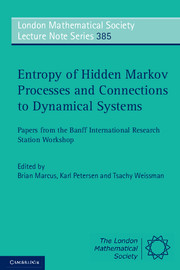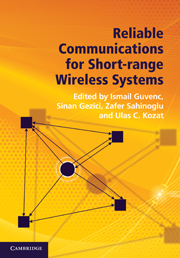Refine search
Actions for selected content:
6790 results in Communications and signal processing
Frontmatter
-
- Book:
- Information Theory
- Published online:
- 05 August 2012
- Print publication:
- 30 June 2011, pp i-vi
-
- Chapter
- Export citation
10 - A packing lemma and the error exponent in channel coding
-
- Book:
- Information Theory
- Published online:
- 05 August 2012
- Print publication:
- 30 June 2011, pp 144-183
-
- Chapter
- Export citation
9 - A covering lemma and the error exponent in source coding
-
- Book:
- Information Theory
- Published online:
- 05 August 2012
- Print publication:
- 30 June 2011, pp 132-143
-
- Chapter
- Export citation
Part I - Information measures in simple coding problems
-
- Book:
- Information Theory
- Published online:
- 05 August 2012
- Print publication:
- 30 June 2011, pp 1-2
-
- Chapter
- Export citation
Preface to the second edition
-
- Book:
- Information Theory
- Published online:
- 05 August 2012
- Print publication:
- 30 June 2011, pp xi-xi
-
- Chapter
- Export citation
11 - The compound channel revisited: zero-error information theory and extremal combinatorics
-
- Book:
- Information Theory
- Published online:
- 05 August 2012
- Print publication:
- 30 June 2011, pp 184-208
-
- Chapter
- Export citation
Part III - Multi-terminal systems
-
- Book:
- Information Theory
- Published online:
- 05 August 2012
- Print publication:
- 30 June 2011, pp 241-242
-
- Chapter
- Export citation
References
-
- Book:
- Information Theory
- Published online:
- 05 August 2012
- Print publication:
- 30 June 2011, pp 461-477
-
- Chapter
- Export citation
4 - Non-block source coding
-
- Book:
- Information Theory
- Published online:
- 05 August 2012
- Print publication:
- 30 June 2011, pp 48-70
-
- Chapter
- Export citation
8 - Computation of channel capacity and Δ-distortion rates
-
- Book:
- Information Theory
- Published online:
- 05 August 2012
- Print publication:
- 30 June 2011, pp 120-131
-
- Chapter
- Export citation
3 - Formal properties of Shannon's information measures
-
- Book:
- Information Theory
- Published online:
- 05 August 2012
- Print publication:
- 30 June 2011, pp 34-47
-
- Chapter
- Export citation
7 - Rate-distortion trade-off in source coding and the source–channel transmission problem
-
- Book:
- Information Theory
- Published online:
- 05 August 2012
- Print publication:
- 30 June 2011, pp 107-119
-
- Chapter
- Export citation

Entropy of Hidden Markov Processes and Connections to Dynamical Systems
- Papers from the Banff International Research Station Workshop
-
- Published online:
- 05 June 2011
- Print publication:
- 26 May 2011

Reliable Communications for Short-Range Wireless Systems
-
- Published online:
- 01 June 2011
- Print publication:
- 24 March 2011
2 - On the preservation of Gibbsianness under symbol amalgamation
-
-
- Book:
- Entropy of Hidden Markov Processes and Connections to Dynamical Systems
- Published online:
- 05 June 2011
- Print publication:
- 26 May 2011, pp 72-97
-
- Chapter
- Export citation
Frontmatter
-
- Book:
- Entropy of Hidden Markov Processes and Connections to Dynamical Systems
- Published online:
- 05 June 2011
- Print publication:
- 26 May 2011, pp i-iv
-
- Chapter
- Export citation
9 - Thermodynamics of hidden Markov processes
-
-
- Book:
- Entropy of Hidden Markov Processes and Connections to Dynamical Systems
- Published online:
- 05 June 2011
- Print publication:
- 26 May 2011, pp 258-272
-
- Chapter
- Export citation
5 - Entropy rate for hidden Markov chains with rare transitions
-
-
- Book:
- Entropy of Hidden Markov Processes and Connections to Dynamical Systems
- Published online:
- 05 June 2011
- Print publication:
- 26 May 2011, pp 172-178
-
- Chapter
- Export citation
1 - Hidden Markov processes in the context of symbolic dynamics
-
-
- Book:
- Entropy of Hidden Markov Processes and Connections to Dynamical Systems
- Published online:
- 05 June 2011
- Print publication:
- 26 May 2011, pp 5-71
-
- Chapter
- Export citation
Introduction
-
- Book:
- Entropy of Hidden Markov Processes and Connections to Dynamical Systems
- Published online:
- 05 June 2011
- Print publication:
- 26 May 2011, pp 1-4
-
- Chapter
- Export citation
